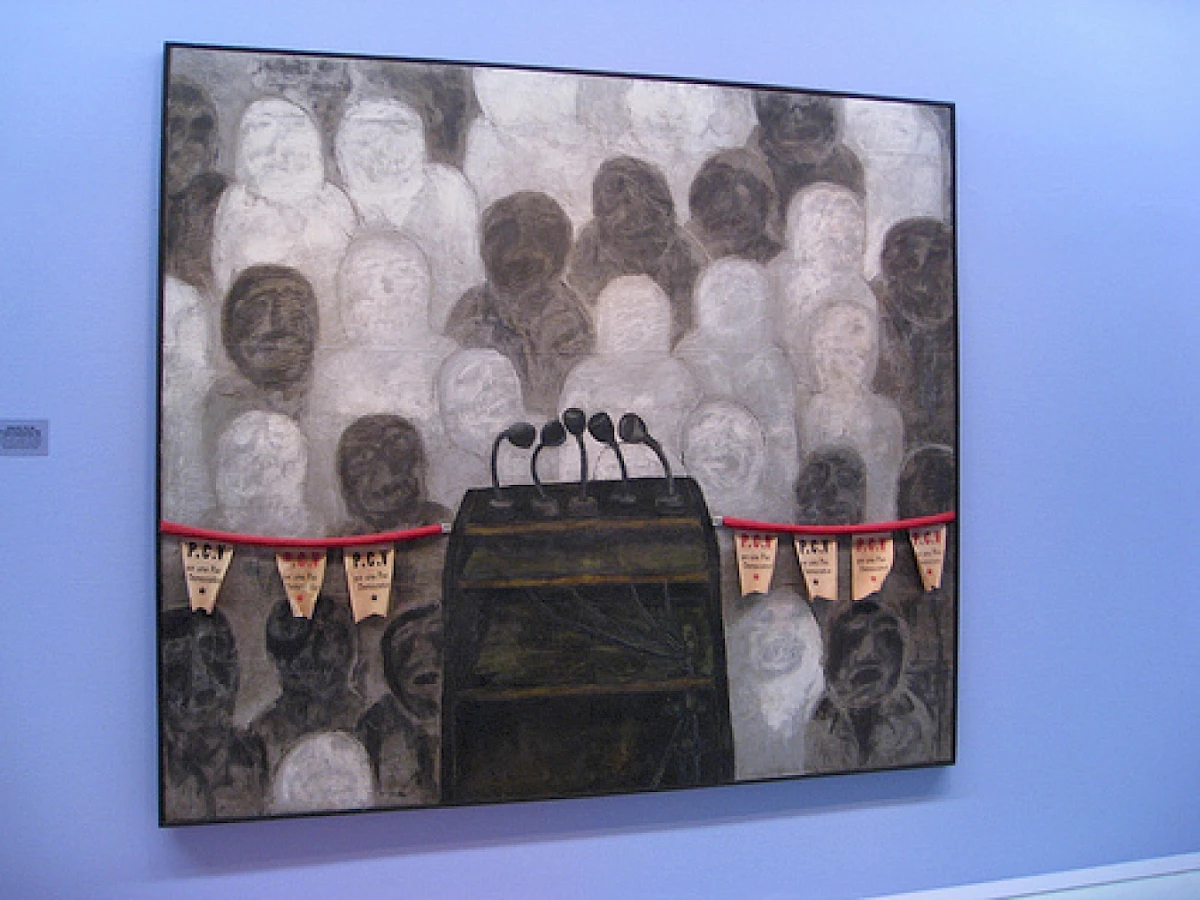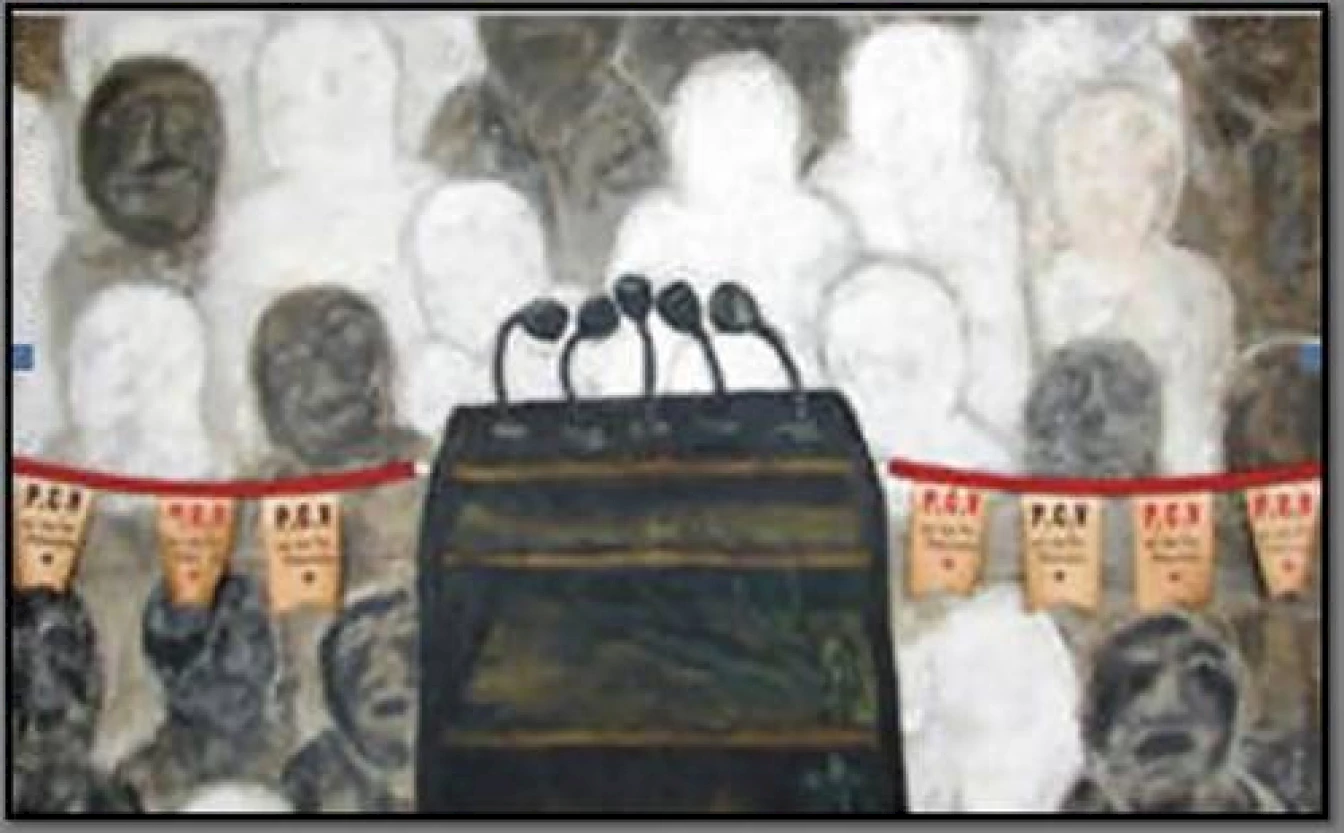
Antonia Eiriz, Una tribuna para la paz democrática, 1968.
(To my grandmother mima who turns one hundred today)
Una tribuna para la paz democrática, Antonia Eiriz's powerful 1968 work, has been repeatedly invoked in relation to works by Tania Bruguera such as Autobiography (2003) and Tatlin's Whisper #6 (2009 and 2014). An empty tribune is placed before the spectator. In Eiriz's painting, an amorphous crowd waits for somebody to speak. They are only spectators. But for that brief space of time, the person standing in front of the painting assumes the place of the speaker. The five microphones point towards us, seemingly inviting us to shed the role of observer and to participate. Unlike previous works by Eiriz such as El vaso de agua (The Glass of Water), in which the distorted and somewhat monstrous figure of the speaker engulfs the space of the painting, this 'tribune' positions the place of enunciation outside, in the space that corresponds to us, or to our absence.
In what sense was this gesture perceived as a threat in Cuba in 1968? What ghosts did it provoke? There was no public call for participation in that work, no allotted number of minutes to speak, and nobody ever actually said a word. Perhaps the mere insinuation that anybody could be in the place of the speaker was problematic. Antonia Eiriz had submitted her 'tribune' to the National Salon in 1968, where it came close to winning a prize until the Stalinist literary critic José Antonio Portuondo, Vice President of the UNEAC1 at the time, appeared on the scene and condemned the work of one of the greats of Cuban art. After that episode, the artist withdrew to her home in Juanelo, where she taught and worked on papier-mâché and community theatre with local residents from her neighbourhood. She did not go back to her painting and assemblages, or exhibit again, for over twenty years. In an interview published in 1994, shortly before her death in Miami, Eiriz said: "When they made those comments, describing my paintings as 'conflictive', I ended up believing them. La tribuna for example, was on the point of winning an award but it didn't because of the criticism. One day I saw all the paintings together for the first time in many years. I said to myself: this painting expresses the moment that I live in. A painter who is able to express the moment she lives in is genuine. So I absolved myself".2
In that same year, 1968, a poem dedicated to Antonia Eiriz was included in the book Fuera del Juego by Herberto Padilla, which won that year's Premio Julián del Casal Poetry Prize, awarded by an honest jury that did not bow to the pressures of the UNEAC. Its publication in Cuba was preceded by a reproving note in which the 'management committee' expressed its disapproval of these books (including Antón Arrufat's Los siete contra Tebas), which it deemed 'ideologically contrary to our revolution', and its belief that 'this poetry and this theatre serve our enemies, and its authors are the artists that they need to fuel their Trojan Horse when Imperialism decides to implement its policy of direct military aggression against Cuba.' The episode known as 'the Padilla case' began with a book of poems, an award being questioned, and ended up with jail, the author's self-incrimination, international condemnation by numerous intellectuals who had until then considered themselves sympathisers of the Cuban Revolution, ruptures, exiles, and so on.

Antonia Eiriz, Una tribuna para la paz democrática, 1968.
There are so many years, but, alas, so few differences separating the disembodied authority of that text by the 'management committee' and these: 'Official Note from the Council of Fine Arts' and 'Statement by the President's Office of the Visual Artists' Association of the UNEAC', both released on 29 December last year, on the eve of the public call for participation in an action in Plaza de la Revolución organised by Tania Bruguera and the platform yo también exijo ('I also demand'). In both texts, the nameless authority that signs these official declarations refers to the action as an 'alleged' and 'so-called' performance. While the first says that it is 'unacceptable' due to its 'manipulation in counterrevolutionary media outlets', the second denounces the fact that 'the initiative has been broadly disseminated by the counterrevolutionary media'. Monkey see, monkey do. Monkey obey.
Antonia's 'tribune' is now conjured up again through Tania's, not just because of the gesture that the two works embody, but also because of the similar institutional censorship that they both came up against. The effects of the censorship are fortunately not the same in the case of the two artists, nor are the contexts in which their practices unfold: the place of the artist has changed, and so has the international visibility and support that is possible today. In a sense, I like to think that Antonia Eiriz's silence can still be heard in Tatlin's Whisper, and in so many other voices. 'Cuban art of recent years is in debt to her art as the art of no other country is: in its critical spirit, in its active sorrow, in its constant non-conformist vocation, the singular mastery of Antonia Eiriz is present in Cuba as nowhere else', wrote the art critic and teacher María de los Ángeles Pereira in a posthumous tribute to the painter.
A few years ago, as part of his project Galería I-Meil, which involves occasional graphic and text interventions sent via email, the artist Lázaro Saavedra shared an image of Antonia Eiriz's Una tribuna para la paz democrática. It was a powerful gesture. The image was sent in 2008, which was the fortieth anniversary of the year that first saw, and soon forgot, the painting. But it was also the year in which Fidel Castro officially announced that he would not accept the position of President of the Council of Sate and Commander in Chief. Accordingly, on 18 February, the newspaper Granma published the last 'Message from the Commander in Chief': 'I am not saying goodbye to you', he wrote, 'I only wish to fight as a soldier of ideas. I will continue to write under the title "Reflections of comrade Fidel". It will be another weapon you can count on. Perhaps my voice will be heard.'
In 2008, the empty tribune may have drawn attention to the absence of that voice whose inflections, accents, and emphasis had repeatedly stood for public discourse in Cuba for almost half a century. Rather than an empty podium awaiting the commander, however, Una tribuna para la paz democrática can be seen as a space that could be occupied by anybody – although not without antagonisms. I'm not really sure whether this was my reading of Antonia Eiriz's work before the last Tatlin's Whisper. Now it seems natural to me.
Translated from Spanish by Nuria Rodríguez Riestra
The views and opinions published here mirror the principles of academic freedom and do not necessarily reflect the views or positions of the L'Internationale confederation and its members.